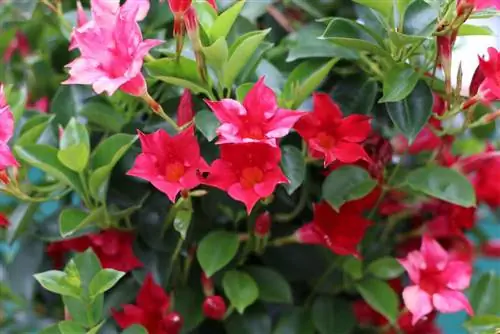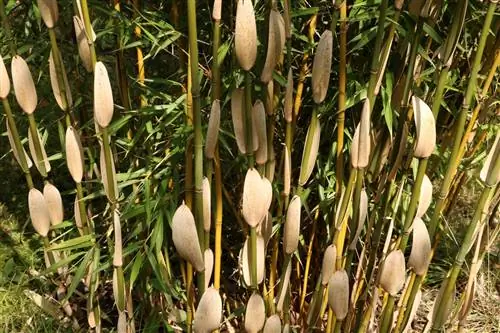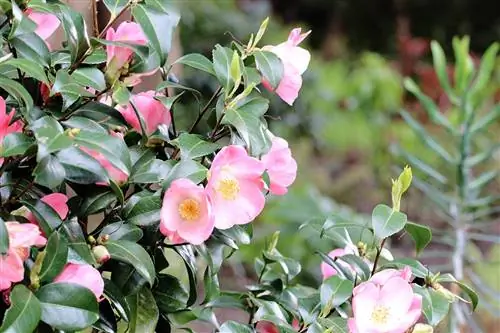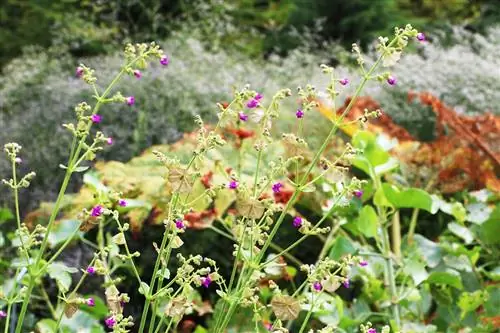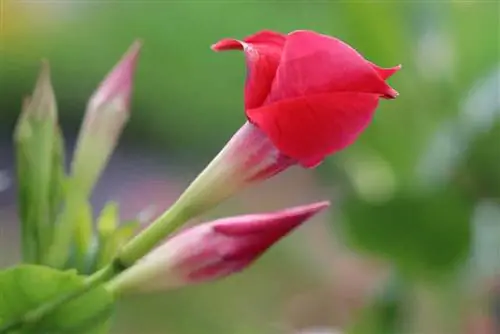- Author admin [email protected].
- Public 2023-12-17 03:39.
- Last modified 2025-06-01 06:48.
The Dipladenia (Mandeville) is not only so popular as a summer balcony plant because of its bushy growth and its undemanding nature when it comes to water requirements, it also provides flowers for years to come. However, only if it is properly overwintered.
Time and place for wintering
Dipladenia is just as undemanding in winter as it is in summer. The basic needs hardly change and many of the conditions and care that are required of them in the warm season also apply to a lesser extent in the winter months. As a real sun worshipper, however, the time at which the Dipladenia is brought into the house from the outdoors is an important indicator of how it will cope with overwintering and develop in the next year. Basically you can say that it makes sense to collect it early because it reacts very sensitively to frost. However, it starts to feel uncomfortable at 7-8 degrees, so the location should actually be changed when the nights start to get cooler, but at the latest when it develops yellow leaves. Under certain circumstances, this could already be the case in early autumn. The Dipladenia is evergreen, so it can and should be overwintered indoors, or even better in a winter garden. It is important that it is in a sunny and bright position without being in direct sunlight. Drafts should also be avoided, you won't get them.
The right care
As an evergreen plant, the Dipladenia needs regular water even in winter, but here too it is content with little. It does not need to be fertilized before or during its winter quarters - this can be done in the spring after it has been hibernated. The following applies to watering in winter:
- Regular watering (every 8-14 days depending on location)
- Soil should not dry out
- no waterlogging
The amount of water should be significantly less than in summer. If the location is too dark, the Dipladenia will develop horny shoots. In this case you should change location. Under no circumstances should it be placed in the immediate vicinity of a radiator, as the temperatures remain as constant as possible and should ideally be around 9 - 15 degrees in the winter quarters (an average of 12 degrees is preferred). The Dipladenia also copes well with high humidity, but rather dry conditions.
This is another reason why you should avoid getting close to radiators. You can also check for pests directly while watering. The usual suspects such as aphids and spider mites appear frequently and must be treated accordingly. Isolation is particularly advisable for spider mites so that they do not infect other plants. A superficial spray treatment with a mixture of water and milk (ratio 10:1) is well tolerated by the plant and is often very effective.
As in its home in the tropics, the Dipladenia wants a warm, bright and moist location. The ideal place would be in a winter garden all year round where it can spread out. It is better to avoid a south-facing window on a window, as it cannot tolerate excessively bright sun. Windows that face east or west are better. A Mandevilla needs regular water with occasional additions of liquid fertilizer, although stagnant moisture has a negative effect.
A humid, tropical environment can be achieved with regular misting. Leaf mold mixed with a little sand is tolerated very well by dipladenias. The substrate should definitely contain humus content. Cutting back is not a problem. You can also go back to perennial wood. During the summer, the plants benefit from a fresh air treatment on the terrace or balcony in a sunny or semi-shady place.
Tips for a successful wintering
So that the Dipladenia Mandeville blooms profusely again next year, it should be cut back before overwintering, not in spring, as the flowers form on the new shoots. The pruning can be done up to 2/3. The Dipladenia may thank you for the draft by producing fewer flowers or no flowers at all. It shouldn't simply be thrown away, but should be given another chance next year. The same applies to overwintering that is too warm.
Leaf drop will probably occur, but it's not a problem as long as the roots are he althy and not rotting (which can happen quickly if you water too much, especially in winter). From February onwards, the plant can be kept warm again, but you should only increase the amount of water hesitantly, as too much water produces many leaves but no flowers. Now it can be placed in the sun again, but not in the blazing midday sun and if possible not directly at the window.
Continue to avoid drafts. After the ice saints, when no more frost is expected, the plant can be put back on the balcony, but it should first be used to the sun. Therefore, a shady spot is preferable initially. You can fertilize and water more abundantly when the first shoots appear.
The Dipladenia needs a resting phase, which should be around 15° C, slightly cooler than during the growing season. Then watering will also be severely restricted. Frost is not tolerated at all, which is why dipladenias should be brought into the house in autumn when the thermometer shows around 10° C.
A Dipladenia makes every flower lover's heart beat faster. Only a few plants can impress you with their joy of growth and flowering. As far as care is concerned, conditions are required that are at least similar to those in tropical areas.
Note sensitivity to frost
The Dipladenia is very sensitive to frost. It should therefore be brought to winter quarters early. A place where the temperature is between 10 and 15 degrees Celsius is ideal. Furthermore, the chosen location should be bright, but not exposed to direct sunlight. Darkness should definitely be avoided with this plant. If it is too dark, many unwanted shoots will form.
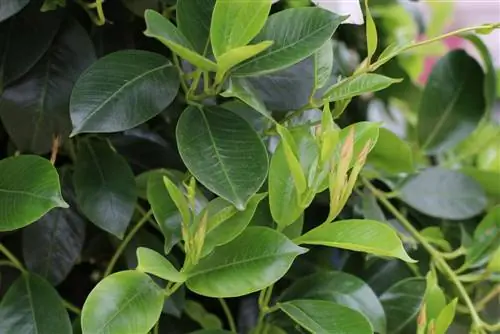
When overwintering a Dipladenia, it is important to provide it with sufficient water. The plant is very leafy and therefore needs enough fluid even in winter. However, you should avoid fertilizing in winter. This should ideally start again in April. The first application of fertilizer should best be done in combination with cutting and repotting.
Allow time to get used to
This procedure makes it easier for the plant to transition between the rest and growth phases. The optimal time for this preparatory work is shortly before moving outside. Before this happens, the temperature should be increased by 2 to 3 degrees Celsius. This announces the end of the rest phase to the plant, initiates the growth phase and, above all, stimulates flower formation.
The Dipladenia tolerates cutting well. However, you shouldn't cut off too much. The ideal time for cutting is towards the end of wintering, but you should wait until the flowering period. As mentioned above, the best time to prune is before moving outdoors, along with the first application of fertilizer and repotting.
Right environment - note sensitivity to frost
The plants of the genus Dipladenia (Sundaville) that can be found in our gardens are mostly special breeds that have been modified to suit the peculiarities of the European climate. They are much more robust than you would expect from a South American plant and do not place similarly high demands on care, soil or overwintering. However, it is important that the plant is overwintered in a draft-free place without bright sunlight. Drafts are generally damaging to the plant and the Dipladenia also does not tolerate bright sunlight well.
If you want to overwinter a Dipladenia (Sundaville), you should ensure that the plant is brought from the outdoors into a winter garden or apartment in good time before the first frost. The plant is in no way frost-resistant; even low frost temperatures can cause great damage to this special plant. The best way to overwinter the Dipladenia (Sundaville) is to place it in a bright and not too warm environment at around 10 - 15 degrees Celsius. These plants cannot tolerate darkness and they then develop many unwanted shoots along with their horny shoots; Overwintering in the basement or in a dark hallway is therefore not recommended. Before putting the plant back outdoors, the temperature should be increased by a good 2 -3 degrees Celsius to stimulate growth and flower formation.
Watering and cutting
In addition to the lush flowers, the Dipladenia (Sundaville) is also characterized by its abundant leaf growth. If you want to overwinter the Dipladenia (Sundaville), you have to take this into account. The plant's many leaves mean that the plant needs to be watered sufficiently even during the winter. You can even prune the Dipladenia (Sundaville) during overwintering, but you should definitely wait for the flowering period, do not prune too much and it is best to prune the plant towards the end of the wintering period before moving it outdoors again. Apart from regular watering, the Dipladenia (Sundaville) does not require any further care during the winter. Above all, you have to make sure that you do not fertilize the plant during this time and that you do not start fertilizing again until April. It is best to combine pruning with fertilization and repotting to ease the plant's transition from overwintering to growing outdoors.
Mandevilla Hybrid -Amabilis, Sanderi
The Dipladenia or Mandevilla belongs to the dogpoison family. As a rule, these are hanging climbing plants, some of whose trunks become woody like a liana.
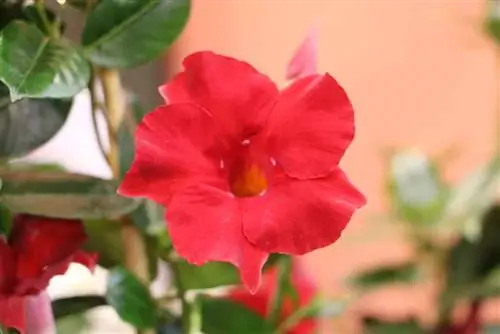
These genera therefore fall under the subshrubs. However, some species also have an upright or lying appearance. The commonly known name Dipladenia has its origins from the Greek words “di” for double and “aden” for gland. This refers to the two glands on the edge of the scar head. The botanical name Mandevilla comes from the fact that an envoy named Henry John Mandevilla took the first plants from Argentina to England.
Mandevilla Hybrids
Crossing different species produced various hybrids. The most famous of them are Mandevilla x Amabilis and Mandevilla Sanderi Hybride.
Mandevilla Hybrid Amabilis
With 10 cm large flowers, Mandevilla Amabilis is the most magnificent species available commercially. The oval, structured leaves are also significantly larger than those of the other dipladenias. Its strong growth of several meters per summer is also unmatched by any other Mandevilla. Overall, the individual shoots reach a length of up to 5 m. As a permanent bloomer, Mandevilla Hybride Amabilis can be grown outdoors from May to September and decorate the terrace and garden with its wonderful pink flowers. A stable climbing frame gives the plant the necessary support
Mandevilla Hybrid Sanderi

